5.5 Calculating Electric Fields of Charge Distributions
Learning Objectives
By the end of this section, you will be able to:
- Explain what a continuous source charge distribution is and how it is related to the concept of quantization of charge
- Describe line charges, surface charges, and volume charges
- Calculate the field of a continuous source charge distribution of either sign
The charge distributions we have seen so far have been discrete: made up of individual point particles. This is in contrast with a continuous charge distribution, which has at least one nonzero dimension. If a charge distribution is continuous rather than discrete, we can generalize the definition of the electric field. We simply divide the charge into infinitesimal pieces and treat each piece as a point charge.
Note that because charge is quantized, there is no such thing as a “truly” continuous charge distribution. However, in most practical cases, the total charge creating the field involves such a huge number of discrete charges that we can safely ignore the discrete nature of the charge and consider it to be continuous. This is exactly the kind of approximation we make when we deal with a bucket of water as a continuous fluid, rather than a collection of molecules.
Our first step is to define a charge density for a charge distribution along a line, across a surface, or within a volume, as shown in Figure 5.22.
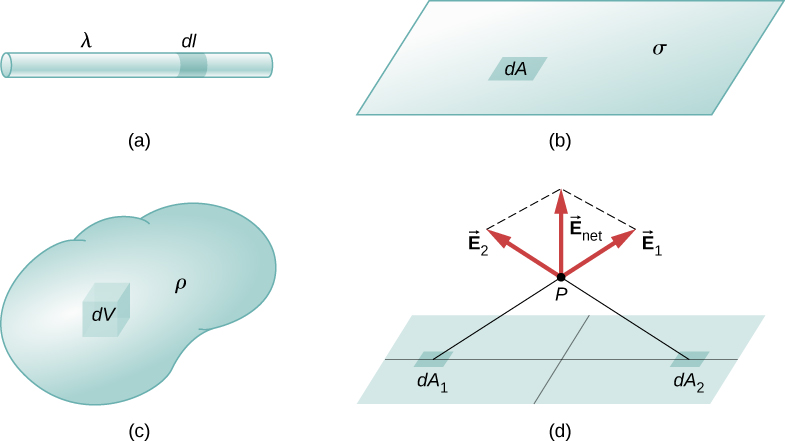
Definitions of charge density:
- charge per unit length (linear charge density); units are coulombs per meter (C/m)
- charge per unit area (surface charge density); units are coulombs per square meter
- charge per unit volume (volume charge density); units are coulombs per cubic meter
Then, for a line charge, a surface charge, and a volume charge, the summation in Equation 5.4 becomes an integral and is replaced by , , or , respectively:
The integrals are generalizations of the expression for the field of a point charge. They implicitly include and assume the principle of superposition. The “trick” to using them is almost always in coming up with correct expressions for dl, dA, or dV, as the case may be, expressed in terms of r, and also expressing the charge density function appropriately. It may be constant; it might be dependent on location.
Note carefully the meaning of r in these equations: It is the distance from the charge element to the location of interest, (the point in space where you want to determine the field). However, don’t confuse this with the meaning of ; we are using it and the vector notation to write three integrals at once. That is, Equation 5.9 is actually
Example 5.5
Electric Field of a Line Segment
Find the electric field a distance z above the midpoint of a straight line segment of length L that carries a uniform line charge density .Strategy
Since this is a continuous charge distribution, we conceptually break the wire segment into differential pieces of length dl, each of which carries a differential amount of charge . Then, we calculate the differential field created by two symmetrically placed pieces of the wire, using the symmetry of the setup to simplify the calculation (Figure 5.23). Finally, we integrate this differential field expression over the length of the wire (half of it, actually, as we explain below) to obtain the complete electric field expression.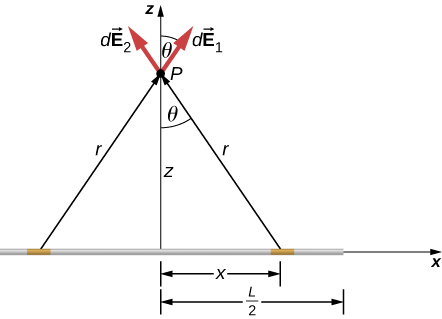
Solution
Before we jump into it, what do we expect the field to “look like” from far away? Since it is a finite line segment, from far away, it should look like a point charge. We will check the expression we get to see if it meets this expectation.The electric field for a line charge is given by the general expression
The symmetry of the situation (our choice of the two identical differential pieces of charge) implies the horizontal (x)-components of the field cancel, so that the net field points in the z-direction. Let’s check this formally.
The total field is the vector sum of the fields from each of the two charge elements (call them and , for now):
Because the two charge elements are identical and are the same distance away from the point P where we want to calculate the field, so those components cancel. This leaves
These components are also equal, so we have
where our differential line element dl is dx, in this example, since we are integrating along a line of charge that lies on the x-axis. (The limits of integration are 0 to , not to , because we have constructed the net field from two differential pieces of charge dq. If we integrated along the entire length, we would pick up an erroneous factor of 2.)
In principle, this is complete. However, to actually calculate this integral, we need to eliminate all the variables that are not given. In this case, both r and change as we integrate outward to the end of the line charge, so those are the variables to get rid of. We can do that the same way we did for the two point charges: by noticing that
and
Substituting, we obtain
which simplifies to
Significance
Notice, once again, the use of symmetry to simplify the problem. This is a very common strategy for calculating electric fields. The fields of nonsymmetrical charge distributions have to be handled with multiple integrals and may need to be calculated numerically by a computer.Check Your Understanding 5.4
How would the strategy used above change to calculate the electric field at a point a distance z above one end of the finite line segment?
Example 5.6
Electric Field of an Infinite Line of Charge
Find the electric field a distance z above the midpoint of an infinite line of charge that carries a uniform line charge density .Strategy
This is exactly like the preceding example, except the limits of integration will be to .Solution
Again, the horizontal components cancel out, so we wind up withwhere our differential line element dl is dx, in this example, since we are integrating along a line of charge that lies on the x-axis. Again,
Substituting, we obtain
which simplifies to
Significance
Our strategy for working with continuous charge distributions also gives useful results for charges with infinite dimension.In the case of a finite line of charge, note that for , dominates the L in the denominator, so that Equation 5.12 simplifies to
If you recall that , the total charge on the wire, we have retrieved the expression for the field of a point charge, as expected.
In the limit , on the other hand, we get the field of an infinite straight wire, which is a straight wire whose length is much, much greater than either of its other dimensions, and also much, much greater than the distance at which the field is to be calculated:
An interesting artifact of this infinite limit is that we have lost the usual dependence that we are used to. This will become even more intriguing in the case of an infinite plane.
Example 5.7
Electric Field due to a Ring of Charge
A ring has a uniform charge density , with units of coulomb per unit meter of arc. Find the electric field at a point on the axis passing through the center of the ring.Strategy
We use the same procedure as for the charged wire. The difference here is that the charge is distributed on a circle. We divide the circle into infinitesimal elements shaped as arcs on the circle and use polar coordinates shown in Figure 5.24.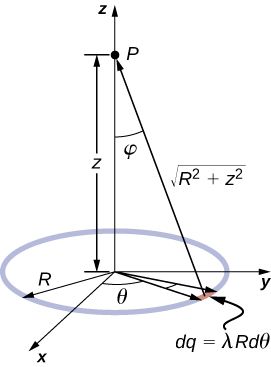
Solution
The electric field for a line charge is given by the general expressionA general element of the arc between and is of length and therefore contains a charge equal to The element is at a distance of from P, the angle is , and therefore the electric field is
Significance
As usual, symmetry simplified this problem, in this particular case resulting in a trivial integral. Also, when we take the limit of , we find thatas we expect.
Example 5.8
The Field of a Disk
Find the electric field of a circular thin disk of radius R and uniform charge density at a distance z above the center of the disk (Figure 5.25)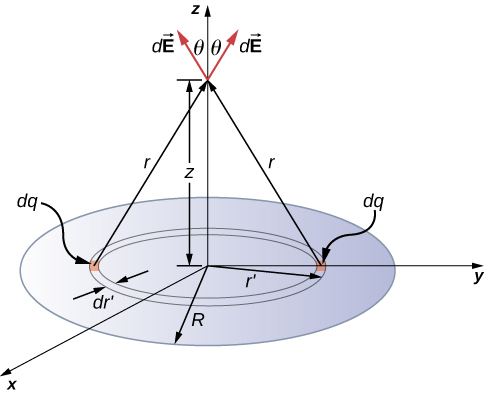
Strategy
The electric field for a surface charge is given byTo solve surface charge problems, we break the surface into symmetrical differential “strips” that match the shape of the surface; here, we’ll use rings, as shown in the figure. Again, by symmetry, the horizontal components cancel and the field is entirely in the vertical direction. The vertical component of the electric field is extracted by multiplying by , so
As before, we need to rewrite the unknown factors in the integrand in terms of the given quantities. In this case,
(Please take note of the two different “r’s” here; r is the distance from the differential ring of charge to the point P where we wish to determine the field, whereas is the distance from the center of the disk to the differential ring of charge.) Also, we already performed the polar angle integral in writing down dA.
Solution
Substituting all this in, we getor, more simply,
Significance
Again, it can be shown (via a Taylor expansion) that when , this reduces towhich is the expression for a point charge
Check Your Understanding 5.5
How would the above limit change with a uniformly charged rectangle instead of a disk?
As , Equation 5.14 reduces to the field of an infinite plane, which is a flat sheet whose area is much, much greater than its thickness, and also much, much greater than the distance at which the field is to be calculated:
Note that this field is constant. This surprising result is, again, an artifact of our limit, although one that we will make use of repeatedly in the future. To understand why this happens, imagine being placed above an infinite plane of constant charge. Does the plane look any different if you vary your altitude? No—you still see the plane going off to infinity, no matter how far you are from it. It is important to note that Equation 5.15 is because we are above the plane. If we were below, the field would point in the direction.
Example 5.9
The Field of Two Infinite Planes
Find the electric field everywhere resulting from two infinite planes with equal but opposite charge densities (Figure 5.26).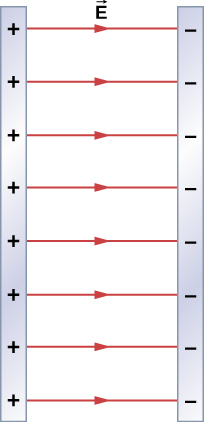
Strategy
We already know the electric field resulting from a single infinite plane, so we may use the principle of superposition to find the field from two.Solution
The electric field points away from the positively charged plane and toward the negatively charged plane. Since the are equal and opposite, this means that in the region outside of the two planes, the electric fields cancel each other out to zero.However, in the region between the planes, the electric fields add, and we get
for the electric field. The is because in the figure, the field is pointing in the +x-direction.
Significance
Systems that may be approximated as two infinite planes of this sort provide a useful means of creating uniform electric fields.Check Your Understanding 5.6
What would the electric field look like in a system with two parallel positively charged planes with equal charge densities?